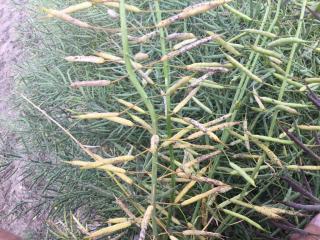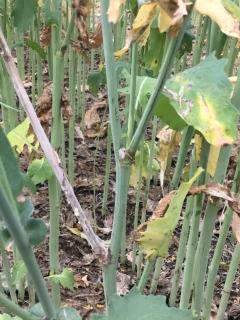Alternaria blackspot and sclerotinia stem rot in canola
Alternaria black spot
- Williams
- Esperance
Plant pathologist Ravjit Khangura (DPIRD) reports seeing alternaria black spot in a canola crop near Williams.
Plant pathologist Andrea Hills (DPIRD) reports that alternaria is also present in the Esperance region with small patches of one crop severely affected.
Spots of alternaria on leaves and pods have a concentric or target-like appearance and are brown, black or greyish white with a dark boarder. Lesions on green leaves are often surrounded by a chlorotic (yellow) halo. Lesions on the pods can be in the form of dark spots of varying sizes. Several spots may join to form large lesions. Severe pod infections may cause seed to shrivel and the pods to prematurely ripen and shatter. Stem spots are elongated and almost black.
Pod symptoms of alternaria are similar to those of blackleg and the two can be difficult to distinguish in the field.
Alternaria can be common in canola crops but is not usually severe enough to warrant control.
For information refer to DPIRD’s Diagnosing alternaria black spot in canola page.
Sclerotinia stem rot
- Katanning
- Kojonup
- Kendenup
Plant pathologist Ravjit Khangura (DPIRD) also reports seeing some sclerotinia stem rot in canola near Katanning, Kojonup and Kendenup.
Sclerotinia infection, similar to alternaria, causes premature ripening of plants and therefore poses the risk of premature shattering.
Most of the WA canola crops are at an advanced stage now. Research conducted by DPIRD has shown that there are no economic returns from late fungicide applications (70-80% bloom) and there is a danger of fungicide withholding period concerns.
For further management information refer to DPIRD’s Managing sclerotinia stem rot in canola page.
Look out for sclerotia in harvested seed
Harvest has already begun in the northern region and will soon begin in other regions for canola, lupin and pulse crops and growers are reminded to check their seed for the presence of sclerotinia sclerotia, especially if they are planning to retain their seed for next year’s crop.
Seasonal conditions have been favourable for sclerotinia in canola this season so there is a high probability that the sclerotia may be mixed with the harvested seed in severely affected crops.
Ravjit advises that sclerotia are resting bodies of the fungus that are generally black in color, 2-20mm in length and can survive in soil for more than four years. They are often colourfully described as looking like ‘rat droppings’.
Growers are urged to carefully inspect their harvested seed and if they find large numbers of sclerotia, the seed should be graded. Ungraded seed used for sowing can inadvertently transfer sclerotia into the soil, which can initiate the disease during the season.
CBH delivery standards also have a maximum allowed level for sclerotia of 0.5% or 2.5g in the 500g sample.
Paddocks with a heavy load of sclerotia should be rotated with non-host crops such as cereals for at least for 3-4 years to allow the sclerotia to decompose. Tillage and deep ploughing can also be employed to bury sclerotia to a depth of more than 15cm. Grinding up sclerotia in a weed seed destructor was discussed in last week’s PestFax Issue 25 article Sclerotinia stem rot in lupins. Tips for minimising the impact on harvested grain quality and planning for next season
Strategies for managing sclerotinia stem rot in 2019
These include;
- Long rotations; sow non-host crops (all broadleaf crops can host sclerotinia)
- Avoiding sowing close to last year’s infected crop
- Using clean seed
- Using foliar fungicide.
Further information about managing sclerotinia stem rot can be found at;
- DPIRD’s 2018 PestFax Issue 25 article Sclerotinia stem rot in lupins. Tips for minimising the impact on harvested grain quality and planning for next season
- DPIRD’s Managing sclerotinia stem rot in canola page
- DPIRD’s Protecting WA Crops Issue 5 newsletter Sclerotinia stem rot
- GRDC’s Managing sclerotinia in canola YouTube video.
For more information on canola sclerotinia contact Ravjit Khangura, Plant Pathologist, South Perth on +61 (0)8 9368 3374 or Ciara Beard, Plant Pathologist, Geraldton on +61 (0)8 9956 8504 or Andrea Hills, Plant Pathologist, Esperance on +61 (0)8 9083 1144.


